Watching Clint Eastwood’s American Sniper (2015) reminded me of Sunday nights spent in front of the television with my parents in the late seventies and early eighties. It was a time before the plethora of viewing options available now and the Sunday movie was a big deal, sometimes the highlight of the week’s viewing. Commercial television was my parent’s drug of choice. More often than not, it seemed, the movie on offer was a war film.
American Sniper is about the life of Chris Kyle (Bradley Cooper), a former US Navy Seal and one of the most lethal snipers in US military history. It is recorded that he had as many as a 160 ‘confirmed kills’, which were accumulated during four tours of duty in the second Iraq war. The film is based on a bestselling book of the same name that Kyle helped write (which I have not read). Prior to watching the film, I’d heard about the controversy around it, including numerous claims it is little more than a pro-Iraq war, Republican Hawk propaganda piece. I am always sceptical when such sweeping statements are used to describe a film. Indeed, despite his conservative views, Eastwood is a veteran director with a proven ability to create a reasonably nuanced depiction of America’s involvement in war.… Read more























